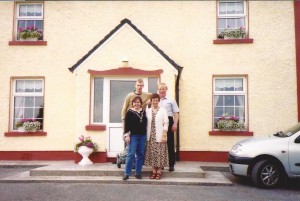Every so often it seems worthwhile to look back over the wide range of Vita Brevis posts and bring some related ones together in one spot. Now that we are half way through the calendar year, some posts on international genealogical research merit a second look. In January, Eileen Pironti wrote about “Reconnecting with family”: in her case, her Irish family in County Roscommon:
“I have enjoyed researching various lines of my family over the years, but my research on the Glennon and Curley families has been the most meaningful to me. It was an amazing experience to stand on the same land in Ireland where my great-grandmother Margaret (Glennon) Curley and her family once lived. More importantly, my father went from not knowing the names of his paternal grandparents to connecting with members of the Curley and Glennon families who were once unknown to us.”
In February, Alice Kane reminded readers that, in China, 2015 is the Year of the Ram (or Sheep):
“For Chinese, the new moon of the first lunar month is celebrated as an opportunity for fresh starts. The waning weeks of the twelfth lunar month, in January or February, are punctuated by intense house cleanings and the obtaining of new clothes for the coming celebrations. Red paper banners with auspicious couplets convey luck and prosperity to all who enter the house. Families visit each other during the first fifteen days of the new year, bringing gifts of oranges and tangerines, symbols of wealth and luck, and feast sumptuously together at home or in restaurants. Red envelopes containing ‘lucky’ money are given to the household’s children and unmarried adults by family elders. As a young child I witnessed many friendly arguments on my home’s doorstep as my parents attempted to press a package of oranges (with a concealed red envelope!) on our departing guests, who in turn tried to leave graciously without it. Not fully understanding this traditional exchange of luck and wealth, I had disliked the loud, boisterous fruit trading enough to call it the ‘orange wars’ – though now I remember it fondly.”
Laura Brown continued her research on her father’s family’s settlement in Mexico in the early twentieth century. The process has taught her patience: “Rather than just jumping in head first like I had done in the past, I figured it was time to learn the basics of Mexican genealogical research. My first stop was the FamilySearch Research Wiki, which offers guides to family history and research for just about every county in the world. One of the guides that I found the most helpful was the Spanish Genealogical Word List, which is just as it sounds: English translations of numbers, census categories, diseases, occupations, and other words that you may encounter when doing research in a foreign language.”
A week later, Sheilagh Doerfler offered readers guidance in a post entitled “My family is Scandinavian … now what?!”:
“Both FamilySearch.org and Ancestry.com have collections of Scandinavian church records, where you can begin the search for your ancestor. But, in my opinion, the best records are housed in each country’s national archives. Many repositories have digitized their collections, and here you can search parish registers, census records, land records, emigrations records, and – my all-time favorite – moving in and out records. In Scandinavia, the minister of the parish recorded the movements of each parishioner. Thus in church records you can find not just your ancestor’s name, birth date, and date of baptism but also the parish he or she came from or the destination parish. A genealogist’s dream!”
In May, Katrina Fahy wrote a well-received piece on “Surname maps for genealogical research” using examples from her own German and Irish ancestry: “Though challenging if the name is common, surname distribution maps can be a helpful way to begin research in your immigrant ancestor’s home country. They can be particularly beneficial, as in the case of my Hampe ancestors, if you know additional surnames, such as their parents’ surnames or the maiden names of their wives.”
And this only scratches the surface: take a look at the International genealogical research tag for recent posts on nationality, Acadia in Canada, the registers of the Irish Petty Sessions Court, Japanese cousins, and the origins of the names given the new royal baby.
Share this:
About Scott C. Steward
Scott C. Steward has been NEHGS’ Editor-in-Chief since 2013. He is the author, co-author, or editor of genealogies of the Ayer, Le Roy, Lowell, Saltonstall, Thorndike, and Winthrop families. His articles have appeared in The New England Historical and Genealogical Register, NEXUS, New England Ancestors, American Ancestors, and The Pennsylvania Genealogical Magazine, and he has written book reviews for the Register, The New York Genealogical and Biographical Record, and the National Genealogical Society Quarterly.View all posts by Scott C. Steward →
